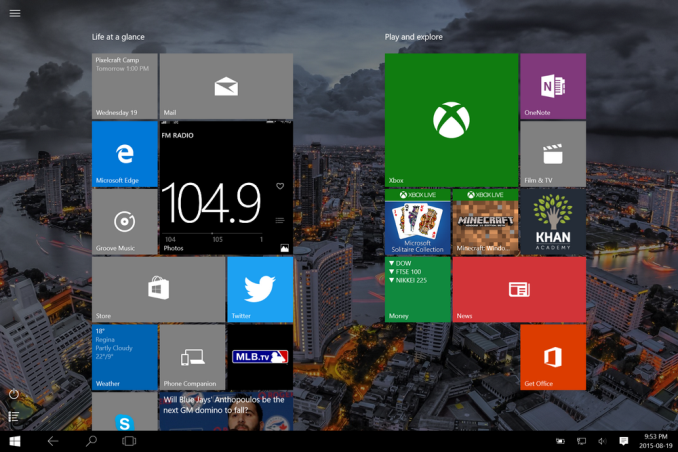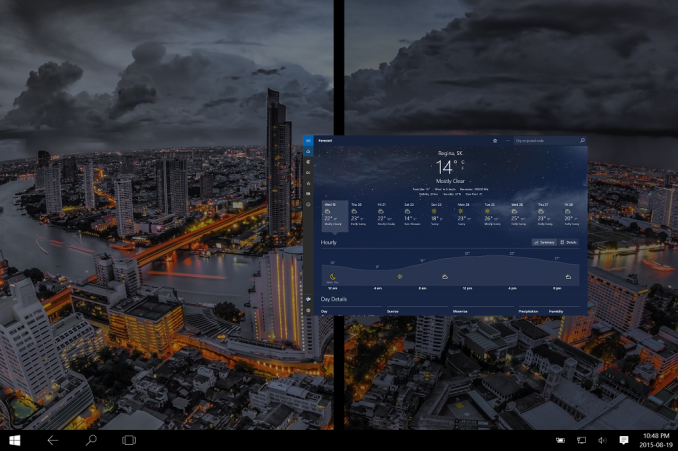The Windows 10 Review: The Old & New Face of Windows
by Brett Howse on August 25, 2015 8:00 AM EST- Posted in
- Operating Systems
- Microsoft
- Windows 10
Continuum
Windows 10’s mission in life seems to be to correct the failings of Windows 8. I think the touch based UI worked pretty well on Windows 8 when using it on a tablet, however forcing that same UI onto traditional PCs was a tough pill to swallow for many people. Windows 10 takes a very different approach, and rather than try to shoehorn a single UI into all devices, the UI itself adapts to each device. Microsoft is branding this transformation as Continuum. You can enable this functionality by turning on tablet mode, which can be enabled as a setting, or if you have a 2-in-1 device, the system will prompt you asking if you want to switch when you move to or from the touch mode. You can of course control how this happens, and even enable it to automatically switch for you without a prompt.
Windows 10 on the PC has a tablet mode which morphs the UI into something that works better with touch. The Start Menu expands to fill the display, much like the Start Screen in Windows 8. This allows the live tiles to take center stage. The UI feels a lot like Windows 8, which is a good thing when using it on a tablet, but there have been some tweaks here too.
Windows 8 went with a lot of hidden gestures to get things done. The charms menu was a swipe in from the right, but there was no obvious way to know that other than stumbling upon it. Multitasking was swiping in from the left to switch between apps, or you could bring up the task switcher with an even more obscure swipe in from the left and then swipe back to the right. Apps could access their options either in the charms or from an app bar that could be opened by swiping up from the bottom or down from the top. There is nothing really wrong with hidden UI gestures but there has to be a way to teach people that they are there. Out of the box on Windows 8 there was very little training. Some was eventually added, but it was pretty sparse.
Windows 10 really moves away from the hidden gestures, and moves things like search to the task bar. Task switching moves from a complicated gesture to the task view button, and there is a back button added as well. Closing apps can be done with task view, or you can still drag the window down off the screen like Windows 8. You can still use some of the gestures, but almost all of the functions can now be accessed by findable onscreen elements.
The one function that is not obvious anymore though is multitasking in tablet mode. In Windows 8, you could swipe an app over to the side and it would snap it there. Windows 10 does not work like this anymore and you have to swipe the app down as if you are going to close it, and then bring it to the side to snap it. It’s actually a pretty easy gesture, it’s just hard to discover on your own. However when you do snap a window, you get Snap Assist again to help you find what you want to snap to the other side.
So there have certainly been some nice changes to the tablet interface as well, and Windows 10 brings some nice features to the touch above and beyond Windows 8. However one thing that I find a step back is the Start Menu when in Tablet Mode. There is a lot of wasted space now, and the Start Menu looks like it is somewhat handicapped to work on a phone display. The tiles now arrange themselves in groups which can be no more than three medium tiles wide. Windows 8’s Start Screen was scrollable horizontally, and Windows 10 only scrolls vertical. Looking at something like the Microsoft Surface 3 shows wide gaps of unusable space when in landscape mode, but switching it to portrait mode means you only get to see a single group, which is a big step back in density over Windows 8. On the Surface 3, there is easily room for three groups of tiles when in landscape, or the groups could be made wider to let you get more on the screen at once. How it is right now though feels very sparse.
Still, Continuum is a much better solution to having Windows 10 adapt to different device types than what has been available before. Forcing a touch UI onto desktop PCs was always going to alienate users. Over the time of Windows 8’s lifecycle, it did evolve to get better on the desktop, but it was never going to win over the fans of Windows 7. With Windows 10, both traditional PCs, tablets, and 2-in-1s can all get the right UI for the right time. It is a big step up for the PC, and on a touch device Windows 10 is pretty nice to use, despite my issues with the Start Menu in full screen. I think this can be sorted out, and I hope it does happen. The new tablet interface offers a lot more in discoverable actions, and it offers quite a bit of customizability.













293 Comments
View All Comments
Brett Howse - Wednesday, August 26, 2015 - link
Thanks for the catch on that one :)abhaxus - Wednesday, August 26, 2015 - link
Had a full screen takeover/scrolling ad when trying to read this article. Similar to the Tom's Hardware ads. I don't read that website anymore, and I will stop reading this one if it continues to happen.Anne Druide - Thursday, August 27, 2015 - link
Only 30 minutes in and it is obvious to me that Microsoft has dropped the ball it had picked up with Windows 8.1. (1) Microsoft's efforts at fixing Windows continue to be APITA (a pain you know where)! WHY did they have to completely obliterate the Charms? Why not just have left them along the right side of the new Action Center? I mean really? Did that NOT cross any of the brilliant minds at MS? WHY remove such a distinctive and unique feature of 8.1. Why not integrate it into 10? (2) Furthermore, just as 8.1 had swung maybe (maybe not) too far towards the tiles, 10 has swung WAY too far towards the desktop. Now, to get to the Metro Tiles Menu it takes TWO steps! Why in the world does pressing the offscreen Window button bring up the Start Menu INSTEAD of the Metro Menu? The Start Menu ALREADY has its own Window icon! And what's a TOTAL WASTE is that pressing on the offscreen Windows button while in Tablet mode and on the Metro Menu does ABSOLUTELY NOTHING! It does not even bring up the Start Menu which would have been a great idea! Duh! (3) Finally, I feel that MS has lied about BRINGING BACK THE START BUTTON! Clicking on the Windows button located where the Start button was in Windows 7 does NOT bring anything up even remotely close to what we had in Windows 7! When I press the Start button I DON'T wanna see tiles; I wanna see all the practical functionality of what came up in Windows 7 when I pressed Start! INSTEAD, I get a very confusing flotsam and jetsam mish-mash of everything under the sun instead of quick access to the Control Panel and Task Bar content and...OMG there's no longer any user control of Windows Update?!!! All in all, my first 30 minutes with Windows 10 has been, as you can tell, VERY disappointing! WHY is it SO HARD for MS to JUST GET IT RIGHT! This is NOT even close to what Windows 10 SHOULD be. This is a limping Windows 9 with the 10 thrown in JUST not to look light years behind Apple's OS X whose TEN has been a thorn in the side of MS for how many years now?!mapesdhs - Thursday, August 27, 2015 - link
Still looks to me like MS wants people to have a phone interface on a desktop, which is stupid. So many things once again look incredibly unprofessional, and the lack of configurability is just ridiculous. It makes the coding of this latest release look so amateurish. The smiley in the very first review image is typical. I could make a list of everything else which is stupid (eg. no Save As from right-button), but who has the time, and I'm sure the 22 pages of comments have covered them all already.I don't want to use an OS that looks like a phone interface. I'll keep using Win7 until MS offers something sensible.
straighttalk - Thursday, August 27, 2015 - link
Totally useless review. No content, just a lot of opinion. Where's the beef? What are the issues? What problems are people who upgrade having?SteelRing - Thursday, August 27, 2015 - link
WiFi Sense is the antithesis of privacy and security, you should allow it if you are naive or an MS worshipper or both. Should you upgrade from Win8(.1)? For sure... Should you upgrade from Win7? I'd say if it aint broke dont fix it. I'm personally glad that Win10 finally allows me to buy laptop again, laptop that works and not just a toy. I want a keyboard and a mouse with my computer and Win10 finally lets me have it again. People who want to smear their screens with their fingers seem to be happy with Win10 too, none of my business though. If Win10 had not come out I'd be scavanging refurb laptops with Win7, thank goodness I don't have to.Oxford Guy - Thursday, August 27, 2015 - link
Microsoft is apparently doing its best to make sure it is broken. Here is a list I found of patches to avoid, due to things like added in "telemetry" (spying) or bug introduction:KB3075249, KB3080149, KB2505438, KB2670838, KB2952664, KB2976978 (8 only), KB3021917, KB3035583, KB3075249
Notmyusualid - Saturday, August 29, 2015 - link
Thanks, but cleared out a couple of those already.Zak - Thursday, August 27, 2015 - link
"for most people, they will make the trade-off of less privacy if it means an improved experience. The textbook example here is advertising, where in order to deliver relevant ads to the user (or rather not serve them useless ads) the ad service must be able to learn something about the user and their preferences" -- Are you out of your mind??? Trade my privacy for relevant ads? You ought to be on drugs or MS is paying you to post this drivel. Nobody likes to be blasted with ads, relevant or not. If they system really wants to learn something it is this: NOBODY LIKES ADS.jameskatt - Friday, August 28, 2015 - link
The absolutely WORSE thing about Windows 10 is now much it is tracking you - tracking the websites you read, the apps you use, tracking how much time you spend on a web page, etc. And you cannot turn this tracking off. It is totally creepy that Windows includes so much spying.Some parents may love this in that they get a monthly report from Microsoft of every webpage and app their children use.
But for the vast majority of users and parents, this is simply unacceptable.
Someone has to give us a privacy utility to block Microsoft from tracking us so heavily.